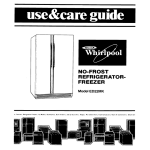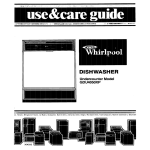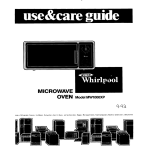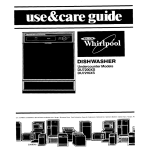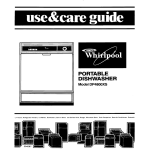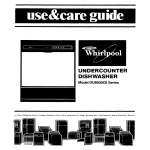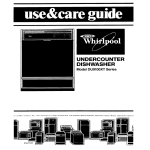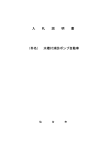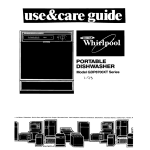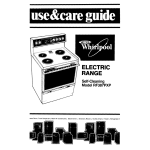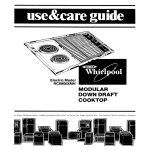Download Whirlpool DU2016XS Specifications
Transcript
DISHWASHER Undercounter Models freezers. Relr~geralor-Freezers. Ice Makers. Dishwashers Built-In Ovens and Surlace Units, Ranges. Microwave Ovens. Trash Compactors. Room Air Condltloners. Dehumldlll Contents Page BEFORE YOU USE YOUR DISHWASHER IMPORTANT SAFETY INSTRUCTIONS PARTS AND FEATURES FOR BEST RESULTS The Filtering System. Quiet Operating Tips PROPERLOADING..................... Top Rack Loading Bottom Rack Loading Silverware Basket Loading ADDING DETERGENT Page 2 2 3 4 4 4 5 5 6 6 7 01987 Whirlpool BEFORE STARTING YOUR DISHWASHER STARTING YOUR DISHWASHER. Changing a Setting Selecting a Cycle To Add a Dish After Starting ENERGY SAVING TIPS SPECIALTIPS COMMON DISHWASHING PROBLEMS IF YOU NEED SERVICE OR ASSISTANCE WHIRLPOOL DISHWASHER WARRANTY 8 8 8 9 9 10 11 12 14 16 Corporation Before you use your dishwasher It is your personal responsibility and obligation to be sure your dishwasher: Is installed by a qualified installer. l Has been installed where it is protected from the elements. l Has been installed on a floor strong enough to support its weight. l Has been properly connected to electricity, water and drain.* l Has been properly electrically grounded.* l Is not used by children or anyone unable to operate it properly. l Is properly maintained. *See installation instructions for complete information. l Parts and features Model DU2000XS and DU2016XS UPPER SPRAY ARM BOTTOM RAC j&A-. DETERGENT DISPENSE Pb WATER COLUMN LOWER SPRAY ARM SILVERWARE BASKET MODEL AND SERIAL NUMBER PLATE (not shown] THE OVERFLOW PROTECTOR is designed to prevent too much water from entering the dishwasher. It is not removable. IOOR COLOR PANEL HEATING ELEMENT \ (Screen Copy your Model and Serial and Removable Numbers When you need service or call with a question, have this information ready: 1. Complete Model and Serial Numbers (from the plate located as shown]. 2. Purchase date from sales slip. Copy this information in these spaces. Keep this book, your warranty and sales slip together in a handy place. Please complete and mail the Owner RegistmtiOn Card turnished with this product. here.. . Model Serial Number Number Purchase Service Date Company and Telephone Number 3 For Best Results Your dishwasher cleans by spraying a mixture of hot. clean water and detergent against soiled surfaces of dishes. When a cycle is started, the dishwasher fills with waterto about the level of the heating element. This water is pumped through the rotating spray arms, drained through the filter system which removes food and soil, and pumped back through the rotating spray arms. Soiled water is pumped out and replaced with clean water during the cycle. Load dishes so soiled surfaces erful spray from rotating arms. face pow- self-cleaning filtering system and removable pump guard help eliminate prerinsing by removing food particles from the The filtering system It Is not necessary to rinse dishes before puttlng them Into the dlshwasher. Just remove large pieces and quantities of food and bones. The filtering system helps keep food particles out of the wash water. Small particles are flushed away as water is pumped out. Larger particles are trapped in the pump guard. To remove the pump guard for cleaning... 1. Wait at least 20 minutes after a cycle the heating element to cool down. 2. Unload and remove the bottom rack. for 3. Press the outside wall of the pump guard at the centerto release the latch. 4. Lift out and rinse clean. To replace the pump guard... 1. Insert pump guard legs [on inside wall) into matching openings in filter screen. 2. Press down on outside wall until latch snaps into place. 3. Replace bottom rack with rack bumpers in front. Water must be hot For best cleaning and drying results, water should 140°F (60°C). 1. Turn on hot water faucet nearest the dishwasher. until it is as hot as possible. 2. Hold a candy or meat thermometer in the stream to measure the temperature. 3. If the temperature is too low, have a qualified the water heater thermostat setting. be at least Let water run of hot water person raise Check Water Temperature Quiet operating tips To avoid thumping and clattering noises during operation: l Make sure lightweight load items are secured in the rack. . Make sure pot lids and handles, pizza pans, cookie sheets, etc. do not touch interior walls 4 or interfere with either of the spray arms rotation. l Load dishes so they don’t touch one another. NOTE: Keep slnk draln plugs Inserted durlng dlshwasher operatlon to prevent noise tmnSfer through dralns. Proper loading Always load dishes so soiled surfaces are reached by spray from rotating Water must be able to drain off completely for best drying results. Be careful items so spray can reach all surfaces. spray arms. to separate Top rack loading CUP AND GLASS LOAD The top rack is designed for cups, glasses and smaller items. l Place so open ends face down for cleaning and draining. l load glasses In top rack only. Bottom rack is not designed for glasses. Damage may occur. Load plastic items only in the top rack. Only plastic items marked “dishwasher safe” are recommended. Plastic items can be melted in the bottom rack. l l l Items with cooked-on soiled surfaces facing or dried-on the spray. foods Place items in the rows between prongs. Placing them over the prongs can lead to breakage. Be sure lightweight items are held firmly in place. China, crystal and other delicate items must not touch each other during dishwasher operation. Damage may occur. l l l l Small bowls, pans anb other utensils can be placed in the top rack. should be loaded in the bottom rack with 5 Bottom rack loading m\ \ Make sure pot handles and other items do not stop rotation of either the upper or lower spray arm. Spray arms must move freely. Securely place heavily soiled cookware face down in rack. l l l DISH LOAD Place plates, soup bowls, etc., between prongs and facing the spray. Silverware basket loading Load the silverware basket while it’s in or out of the bottom rack. The loaded basket should be in the right front corner of the . Load cookie sheets, cake pans and other large items at sides and back. Loading such items in front may keep water spray from reaching detergent dispenser. NOTE: Do not load glasses, cups or plastic items in the bottom rack. l When lower rack is removed, replace with bumpers in front. and spoons so they don’t nest together. Spray can’t reach nested items. Mix items in each section of the basket with some pointing up and some down. Small items- baby bottle caps, jar lids. l 6 Make sure sharp items [knives, forks, skewers, etc.] are put in point down. Make sure long items do not stop the upper spray arm from turning. Adding detergent The kind and amount of dishwasher detergent you use is an important getting your dishes clean. Read this section carefully. Use automatic dlshwasher detergent only. Other detergents are too mild and much too sudsy to work in the dishwasher. Different brands of dishwasher detergent have different amOUntS of phosphorus. Phosphorus softens water and helps prevent water spots on dishes. If water is hard and phosphorus content is low (8.7% or less], you may need to use more detergent or use a brand with a higher phosphorus content (12% or higher). Do not add detergent until you are ready to wash. Fresh automatic dlshwasher detergent Is necessary for best washing results. Store detergent tightly in a cool dry place. How much detergent The detergent part of dispenser The detergent dispenser has one section a cover and one without. l Put detergent in both sections. l Push the cover down until it is latched. The cover opens automatically when the main wash starts. Detergent in the open section falls into the dishwasher when the door is closed. CQVER CovEy with LATCH PHOSPHORUS CONTENT to use The amount of detergent to use depends on the hardness of your water. If too little is used, dishes won’t be clean. However, if too much is used in soft water, glassware will begin to etch. Find out your water’s hardness by asking your local water department, water softener company or VW county extension agent. @ ,o HARD-Fill both sections to top r line if water is 8 or more grains of hardness. l MEDIUM - Fill both sections to middle line if water is 5 to 7 grains hardness. Of SOFT - Fill both sections to bottom line if water is 0 to 4 grains hardness. Of Before starting your dishwasher 1. Spin the Upper Spray Arm to make sure nothing will stop it from turning freely. 2. Push door firmly when closing and it will automatically latch. 3. Run hot water at sink nearest dishwasher until it is hot. Turn it off. Starting your dishwasher HEAT DRY cycle... Turn Cycle Control Knob clockwise to dot marked HEAT DRY CYCLE START. The dishwasher will automatically start that cycle. AIR DRY cycle... Turn Cycle Control Knob clockwise marked AIR DRY START.The dishwasherwill matically start that cycle. to dot auto- RINSE & HOLD cycle... Turn Cycle Control Knob clockwise to dot marked RINSE & HOLD. The dishwasher will automatically start that cycle. Changing a setting You can change a setting anytime during any cycle. 1. Press in the door latch to unlatch the door and stop the cycle. 2. Turn the Cycle Control Knob clockwise to the cycle you want. 8 3. Be sure the detergent dispensers are filled properly for the new cycle. 4. Close and latch the door. The dishwasher will automatically start the new cycle. Selecting a cycle HEAT DRY Cycle If the HEAT DRY Cycle is selected, air in the dishwasher is heated during the”dry” part of the cycle. (The Energy Guide label data is based on this cycle.) Cycle time is about 65 minutes. AIR DRY Cycle If the AIR DRY Cycle is selected, air in the dishwasher is not heated. Using this option helps save energy, but dishes take longer to dry (overnight] and some water spotting may result. Some items (such as plastics) may need towel drying. For best results, use a solid rinse aid. RINSE & HOLD Cycle For rinsing a few items to be washed one or more days later. Cycle time is about 10 minutes. To add a dish after starting 1. To be sure the added item is washed and rinsed, add the item before the end of the main wash. 2. Push up on door latch to unlatch door and stop the cycle. 3. Open the door and add the dish. 4. Close the door. Do not latch it. Wait seconds for air in the dishwasher to warm This helps reduce the amount of moisture can come from the vent when restarting cycle. 5. Press in door to latch it. The dishwasher start where it stopped. 30 up. that the will Energy saving tips You can help save energy if you: 1. Wash full loads. Running a half-filled dishwasher uses the same amount of electricity and hot water as a fully loaded machine. 2. Air dry dishes drying cycle. (overnight). when you don’t need a rapid Allow longer drying times 3. Don’i pre-rinse normally soiled dishes. Use the recommended amount of detergent for good washing results without hand rinsing. 4. load correctly for best washing results. Incorrect loading may cause poor washing and the need to rewash all or part of the load 5. Kitchen cleanup can be done quickly and efficiently through the use of your dishwasher. Most appliance parts that can fit in the dishwasher can be cleaned by it. Burned-on soil, however, should be cleaned by hand. 6. Use your dishwasher during off-peak hours. Local utilities recommend this to avoid heavy usage of energy at certain times of day. 10 Special tips on dishwasher use Remember, use your dishwasher only for the job it was designed to do. Some items are not dlshwasher safe or may require special care. Read these special tips tor the following items: AhlminUm: Aluminum loses its bright, shiny appearance and darkens in color due to minerals in the water and the alkalinity of the dishwasher detergent. Colored aluminum may fade. TIPS: If washed in the dishwasher avoid placing directly in front of detergent dispenser where it could be sprinkled with undissolved detergent, causing spotting, pitting, and discoloration. Follow utensil manufacturers’ cleaning instructions. China: Hand-painted, metal-trimmed, and antique china may fade due to high water temperatures and alkaline detergent solution in the dishwasher. TIPS: Delicate, antique items should not be washed in the dishwasher. Load carefully. Do not allow pieces to touch each other. Test one piece by washing it daily in the dishwasher for several weeks. Then compare it with the rest of the set to see if colors have changed. and decorative CI’yStal &lSSeS: Crystal can break from sudden exposure to high water temperature. Metal trim and colorful decoration on glass will fade in time when washed in the dishwasher. TIPS: Delicate, antique items should not be washed in the dishwasher. Load carefully in top rack only. Be sure to load a few larger items in the bottom rack to reduce amount of force of water spray reaching glassware from lower spray arm. Use the shortest cycle. Flatware: Salty and acidic foods may tarnish silver and stainless flatware if allowed to remain on the utensils. A film may form on sterling silver and silver plate items washed in a dishwasher. This film is caused by reaction of silver with chlorine in the detergent. Gold flatware is not dishwasher safe. TIPS: Rinse flatware as soon as possible, especially if it is not to be washed right away. Dishwasher detergent may remove antique finishes. Wash by hand. Tarnish and film build-up can be removed with silver polish. (w$;isioII UteUSik The seasoned TIPS: Wash by hand. To re-season, hour or two. finish will be removed coat with unsalted PlaStiCS: Many plastics will have “Dishwasher heat sensitive and may melt or warp. TIPS: If in doubt, try one piece. additional protection. Non-stick finish Utl?UdS: TIPS: Follow manufacturers’ Place in upper in the dishwasher. fat and heat in a slow oven for an Safe” written on them. Some plastics rack only. AIR DRY option Most can be washed suggestions. Rusting are provides in the dishwasher. Wood: Many wooden items will crack and warp or lose their finish. TIPS: Do not wash cutting boards, wooden salad bowls or knives dles In the dishwasher. Pewter pewter-like materials: Or TIPS: To keep. .pewter with wooden May streak, discolor, and pit. at its verv best, hand wash with mild deteraent. Dishwasher care & cleakg: Exterlor - Regular use of a soft damp cloth or sponge and a mild detergent is all that is necessary, in most cases, to keep the outside of your dishwasher nice looking a clean. lnterlorHard water minerals may cause a white film to build-up on the inside surfaces, especially just beneath the door area. Wear rubber gloves when cleaning the dishwasher interior. Do not use any type of cleanser other than dlshwasher detergent because 5 lt may cause foaming or sudsing. han- Common dishwashing problems PROBLEM CAUSED BY SOLUTION Spottlng and fllmlng [hard water film) Hard water Fill detergent tergent with be necessary dispensers to capacity. Use dishwasher highest available phosphorus content. to install water softener. deMay To 1. 2. 3. remove spots and film, try a vinegar rinse... Wash and rinse load OS usual. Use AIR DRY Remove all metal items. Put 2 cups (500 mL) white vinegar in CI container on the bottom rack. A. Run dishwasher through a complete washing cycle. Water is not hot enough Water temperature should be at least 140°F (60°C). Set water heater thermostat to CI higher setting. Run water at sink until hot before starting. Not enough detergent, or improper detergent “0ld”detergent Use more dishwasher detergent. Use detergent est available phosphorus content...especially water. Improper loading No rinse aid AIR DRY Setting not dry Chlpplng breaking glassware 12 or so spray Do not ovreaching package of glasses Not enough detergent, or improper detergent Use more dishwasher detergent. Use detergent est available phosphorus conteni especially water. Water is not hot enough Water temperature should be at least 140°F (60°C). Set water heater thermostat to a higher setting. Run water at sink until hot before starting. Water pressure may be low, dishwasher is not filling properly If water pressure while dishwasher Water is not hot enough Water temperature should be at least 140°F (60°C). Set water heater thermostat to a higher setting. Run water at sink until hot before starting. Improper Make sure dishes and glassware are loaded so spray reaches all surfaces and items drain properly. Do not overload. Do not nest Items Try o bar rinse aid such OS Solid Jet DRY”. Follow package directions. Allow more time when usina AIR DRY ODtion, or use HEAT DRY, Plastic items may need-iowel drying. loading No rinse aid on Make sure dishes and glassware are loaded reaches all surfaces and items drain properly. erload. Do not nest items Make sure large items do not block spray from detergent dispensers. Try a bar rinse aid such as Solid Jet DRY’. Follow dlrections. Drying without heat may result in some spotting and silver. closed Do not “0ld”detergent AIR DRY Settmg Black marks dlshes Use only fresh dishwasher detergent. Store tightly container, in cool, dry place. Discard old detergent. fill dispensers until ready to start dishwasher. Check spray arms to make sure they turn freely after loading. Be sure a utensil has not prevented theirturning. Use only fresh dishwasher detergent. Store tightly closed container, in cool, dry place. Discard old detergent. Do not fill dispensers until ready to start dishwasher. Spray arm or arms not rotating freely Small particles deposlted on Items Dishes used with highwith hard used with highwith hard is low, do not use water for other purposes is running (to assure correct fills). Aluminum utensils rubbing against items during washing Use care In loadlng alumlnum utensils, especially any llghtwelght toll container. Place so they do not touch dishes. Remove black marks with plastic scouring pad and a mild abrasive cleanser. Improper Do not overload. Load glasses in the top rack only Load between prongs, not over them. Glasses loaded over prongs will not be supported and may chip or break. loading PROBLEM CAUSED BY SOLUTION Dishes not washing clean Water is not hot enough Water temperature should be at least 140°F (60°C). Set water heater thermostat to a higher setting. Run water at sink until hot before starting. Improper Make sure dishes and glassware are loaded so spray reaches all surfaces and items drain properly. Do not overload. Do not nest items. Make sure large items do not block spray from reaching detergent dispensers. loading Spray arm or arms not rotating freely Not enough or improper detergent detergent “0ld”detergent Water pressure may be low, dishwasher is not filling properly Check spray arms to make sure they turn freely after loading. Be sure a utensil has not prevented their turning. Use more dishwasher detergent. Use detergent with highest available phosphorus content...especially with hard water Use only fresh dishwasher detergent. Store tightly closed container, In cool, dry place. Discard old detergent. Do not fill dispensers until ready to start dishwasher. If water pressure is low, do not use water for other purposes while dishwasher is running (to assure correct fills). Cloudy film on glassware, etching permanent corrosion loo much detergent in soft water Check for rainbow hue on glasses. A rainbow hue is the first sign of etching (corrosion of glass]. Reduce the amount of dishwasher detergent. Use a detergent with a lower phosphorus content. Inadequate If water pressure is low do not use water for other purposes while dishwasher is running [to assure correct water fills). Make sure dishes and glassware are loaded properly to assure adequate rinsing and draining. Do not overload. Dishes & interior ot dishwasher Yellow or brown iron or manganese water Rust spots on stalnless steel -ORDark spots on flatware stainless steel, sllver plate, or sterling Allowing salty or acidic foods such as mayonnaise. vinegar, fruit juices, salad dressings, milk products to remain on flatware. Undissolved detergent coming in contact with flatware Rinse flatware that is to stand for several hours before washing (use Rinse & Hold]. Clean stained items with silver polish and re-wash. Do not put stainless steel and silver flatware in the same silverware basket compartment. Direct contact between these metals can cause permanent damage lo the silver. Bronze tarnish on silverplate Silverplate is worn off. Exposed base metal to kes on a bronzed hue. Remove Water iett in bottom ol dishwasher Dishwasher completed Allow Clogged gap rinsing in cycle drain not air Temporary remedy: 1. Set empty dishwasher for a “one wash” cycle. 2. Start dishwasher and unlatch door to stop it when it has filled for the wash part of the cycle. 3 Add ‘/4 to ‘A cup (120 to 240 mL) of citric acid crystals (usually available in drugstores). 4. Close and latch door to complete cycle. Permanent solution: Install an Iron or mangcnese filter to home water supply. Remove spots with silver polish. Avoid spilling detergent concentrated on wet flatware. tarnish dishwasher with silver polish. to complete Have silver replated. cycle. Some plumbing codes require use of a drain air gap between an undercounter dishwasher and the drain system of the house. The air gap is usually located above the sink or on the top of the counter nearthe dishwasher to prevent the possibility of water backing up from the drain into the dishwasher due to a plugged drain. The drain air gap is NOT a part of the dishwasher and is NOT covered by the dishwasher warranty. The drain air gap should be kept clean to insure proper draining of the dishwasher If you need service or assistance, we suggest you follow these five steps: 1. Before calling for assistance... 3. If you need service*... Performance problems often result from little things you can find and fix yourself without tools of any kind. If your dishwasher will not run, or stops during a cycle: l Is the door tightly closed and securely latched? l Has the cycle been correctly set? l Is the water turned on? l Have you checked your home’s main fuses or circuit breaker box? l Is the dishwasher wired into a live circuit with the proper voltage. l If the motor has stopped because of an overload, it will automatically reset itself within a few minutes. If the motor does not start, call for service. If water remains in the dishwasher: completed? l Has the cycle l A small amount of remaining water is normal. l Is drain air gap clogged? If detergent remains in the covered detergent cup: l Is the bottom rack in backwards? (The rack bumpers should be at the front.) l Is the dishwasher detergent fresh and dry without lumps? l Is the cycle completed? 2. If you need assistance%. Call Whirlpool COOL-LINE@ service assistante telephone number. Dial free from anywhere In the U.S.: l-800-253-1301 and talk with one of our trained Consultants. The Consultant can instruct you in how to obtain satisfactory operation from your appliance or, if service is necessary, recommend a qualified service company in your area. Whirlpool has a nationwide network of franchised TECH-CARE@ Serv. , ice Companies. k TECH-CARE service technicians are 2 trained to fulfill the 7mH-CARE product warranty SERVICE ““1 FRANCHISED and provide afterwarranty service, anywhere in the United States. To locate TECHCARE service in your area, call our COOL-LINE service assistance telephone number (see Step 2) or look in your telephone directory Yellow Pages under: ELECTRICAL APPLIANCESMAJOR - REPAIRING 8 PARTS APPLIANCES-HOUSEHOLDMAJOR-SERVICE 8 REPAIR OR WH,RLPOOt APPLIANCES FRANCHISEDTECH CARESERVICE WHIRLPOOL APPLIANCES FRANCHISEDTECH CARESERVICE .SEHI,,‘E~‘,,.w,:-l.v,t.\ SERVIC‘E (‘0.Ml’A.~/ES XYLSERVICECO 123MAPLE XYZSERVICECO 123MAPLE 999-9999 999~9999 OR WASHING MACHINES, DRYERS 8 IRONERS-SERVICING WHIRLPOOL APPLIANCES FRANCHISEDTECH CARESERVICE StXL’Ic‘E~‘o.IIPAII\.YIES XYZSEAVICECO 123MAPLE 999 9999 4. If you have a problem%. Call our COOL-LINE service assistance telephone number [see Step 2) and talk with one of our Consultants, or if you prefer, write to: Mr. Robert Stanley Division Vice President Whirlpool Corporation 2000 US-33, North Benton Harbor, Ml 49022 5. If you need FSP” replacement parts? . . FSP is a registered trademark of Whirlpool Corporation for quality parts. Look for this symbol of quality whenever you need a replacement part for your Whirlpool appliance. FSP replacement parts will fit right and work right, because they are made to the same exacting specifications used to build every new Whirlpool appliance. *If you must call or write, please provide: model number, serial number, date of purchase, and a complete description of the problem. This information is needed in order to better respond to your request for assistance. 14 Notes TKirlpool Home A /Apphances Making your world a little easier. Part No. 304286 01987 Whirlpool Makers Otshwashers Bu~ll-In Ovens Rev. A Corporation and Surlace Units. Printed in U.S.A. Ranges. Microwave Ovens, Trash Compactors Room Air Condltloners, Oehumldlflers. Automatic Washers, Clothes Ori
















